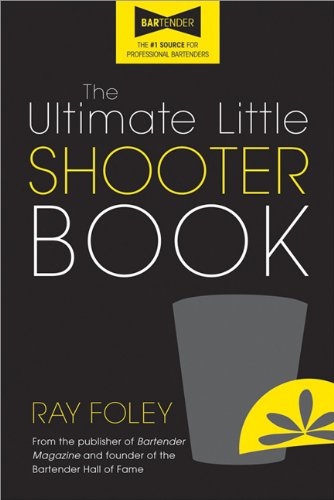Items related to The Ultimate Little Shooter Book (Ultimate Little Books)

Synopsis
"Ray Foley is known as the bartender's bartender. Leave it to him to take the mystery out of mixology!"
-Legendary spirits master, author, and marketer Michel Roux
Bartenders don't rely on just anyone to create shots and shooters. They turn to Bartender Magazine, published by thirty-year industry veteran Ray Foley, trusted by more than 150,000 barkeeps.
Now, you can get your quick sips straight from the top-from Bartender and the best mix masters across America. From sophisticated to fun, this is the only shooter book you'll ever need.
"synopsis" may belong to another edition of this title.
About the Author
Ray Foley is an expert bartender and publisher of Bartender Magazine. He is also the founder of the Bartenders Foundation Inc. and the author of Bartending for Dummies. He has appeared on ABC-TV News, CBS News, NBC News, Good Morning America and Live with Regis and Kathie Lee. He has also been featured in major magazines, including Forbes and Playboy. Ray resides in New Jersey with his wife and partner, Jaclyn.
Excerpt. © Reprinted by permission. All rights reserved.
A SHORT HISTORY OF SHOT GLASSES
BY MARK PICKVET
Tiny glass vessels were once filled with lead shot and were then used to clean and support quill pens. This origin of the word shot had its beginnings in Europe. The shot glass is an American term for a tiny drinking vessel used for serving whiskey in single measures.
Before the widespread use of the word shot in the late nineteenth century, there were a variety of other terms used to describe them. Dram glasses and firing glasses were popular in England dating back to the early eighteenth century. Dram glasses were cheaply made of thin metals and broke easily but were used heavily in the practice of dramming. Dramming involved drinking several small toasts of rum, gin, brandy, or whiskey in succession, ordinarily in lodges, taverns, and even specialty dram shops. Firing glasses were stronger articles of thick glass, particularly the bottoms. They could withstand considerable abuse and were typically slammed bottom up on the table after each successive toast. The resulting noise was comparable to that of a musket firing, hence the name firing glass. In America, toy whiskey tasters was the term for the first generation of tiny whiskey tumblers because they were so small (most had a capacity of barely an ounce). They date back to the 1830s and were used for sampling whiskey.
One of the most significant eras in shot-glass history began in the 1880s and lasted up to Prohibition when the amendment was ratified in 1919. Before Prohibition, clear or crystal shot-sized glasses were produced as a form of advertising. Naturally the advertising was alcohol-related and intended for proprietors, distillers, store owners selling whiskey, pharmacists and doctors dispensing liquor, and patrons of saloons, clubs, and so on. Salesmen, peddlers, and agents offered free samples of whatever product they were promoting in shot-sized glasses. Other shot glasses were produced in cut crystal and garish carnival colors during the Depression era. A new style of shot glass was made during the 1920s and 1930s; it was 2 7/8 inches tall, narrower, held exactly one ounce, and had an incredibly thick bottom. But there were some with bottoms so thick their capacity was less than an ounce: customers often referred to them as cheaters.
Manufacturers printed popular toasts on shot glasses, such as "Here's Looking at You," "Bottoms Up," "Down the Hatch," "Just a Swallow," and many others. In the post-Depression era, the decorated tumbler soon became the most popular medium for shot-glass production. Machine-applied enamels and heat-transfers were cheaply fused to shot glasses in huge numbers. Shot glasses decorated with advertising, sports teams, Christmas and other holiday motifs, plain patterns, and logos from tourist hot spots have characterized the post-Depression era. Production of thick, durable shot glasses for bar use has never wavered since the time of the firing glass.
INTRODUCTION
All recipes have been alphabetized for your convenience.
Techniques for Mixing
1. Build: Pour one liquor on top of the other, per recipe, so that ingredients mix.
2. Layer: Pour the first ingredient, then hold a bar spoon slightly above it and pour the next ingredient so that the bottom layer is not penetrated. Repeat with each liquid ingredient.
3. Shake and strain: Shake with ice and strain.
4. Float: Similar to layering, except the floated ingredient is added to a finished drink and, unlike a layer, gradually blends in.
*We do not recommend flaming any shooter.
Publisher's Note: This book and the recipes contained herein are intended for those of a legal drinking age. Please drink responsibly and ensure you and your guests have a designated driver when consuming alcoholic beverages.
"About this title" may belong to another edition of this title.
- PublisherSourcebooks
- Publication date2010
- ISBN 10 1402242654
- ISBN 13 9781402242656
- BindingPaperback
- Edition number2
- Number of pages480
- Rating
Shipping:
FREE
Within U.S.A.
Buy New
Learn more about this copy
Shipping:
FREE
Within U.S.A.
Top Search Results from the AbeBooks Marketplace
The Ultimate Little Shooter Book (Ultimate Little Books)
Seller: ThriftBooks-Dallas, Dallas, TX, U.S.A.
Paperback. Condition: Good. No Jacket. Pages can have notes/highlighting. Spine may show signs of wear. ~ ThriftBooks: Read More, Spend Less 0.65. Seller Inventory # G1402242654I3N00
Quantity: 1 available
The Ultimate Little Shooter Book (Ultimate Little Books)
Seller: SecondSale, Montgomery, IL, U.S.A.
Condition: Very Good. Item in good condition. Textbooks may not include supplemental items i.e. CDs, access codes etc. Seller Inventory # 00047191275
Quantity: 1 available
The Ultimate Little Shooter Book (Ultimate Little Books)
Seller: The Book Spot, Sioux Falls, SD, U.S.A.
Paperback. Condition: New. Seller Inventory # Abebooks390966
Quantity: 1 available

